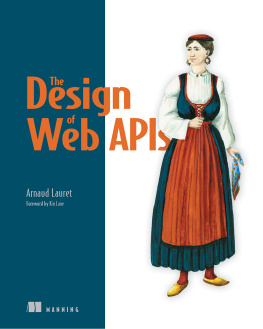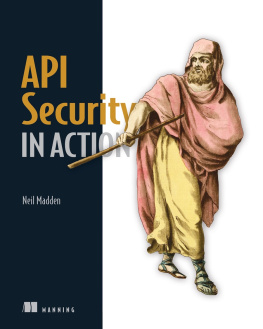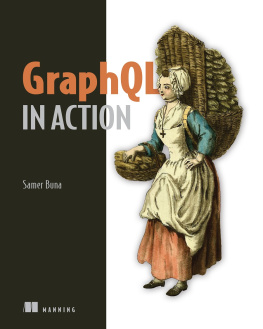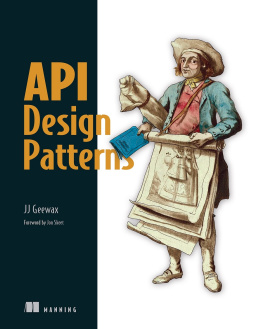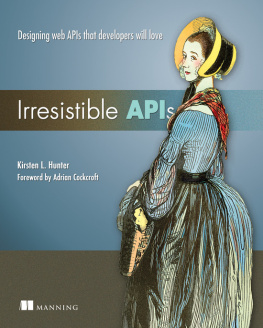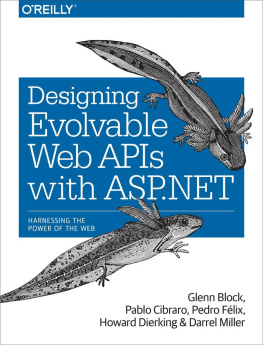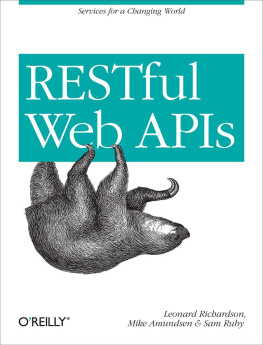The Design of Web APIs
Arnaud Lauret
Foreword by Kin Lane
Manning
Shelter Island
For online information and ordering of this and other Manning books, please visit www.manning.com. The publisher offers discounts on this book when ordered in quantity.
For more information, please contact
Special Sales Department
Manning Publications Co.
20 Baldwin Road
PO Box 761
Shelter Island, NY 11964
Email:
2019 by Manning Publications Co. All rights reserved.
No part of this publication may be reproduced, stored in a retrieval system, or transmitted, in any form or by means electronic, mechanical, photocopying, or otherwise, without prior written permission of the publisher.
Many of the designations used by manufacturers and sellers to distinguish their products are claimed as trademarks. Where those designations appear in the book, and Manning Publications was aware of a trademark claim, the designations have been printed in initial caps or all caps.
Recognizing the importance of preserving what has been written, it is Mannings policy to have the books we publish printed on acid-free paper, and we exert our best efforts to that end. Recognizing also our responsibility to conserve the resources of our planet, Manning books are printed on paper that is at least 15 percent recycled and processed without the use of elemental chlorine.
Manning Publications Co.
20 Baldwin Road
PO Box 761
Shelter Island, NY 11964
Development editor:Jenny Stout
Technical development editor:Michael Lund
Review editor:Ivan Martinovi
Production editor:Deirdre Hiam
Copy editor:Frances Buran
Proofreader:Melody Dolab
Technical proofreader:Paul Grebenc
Typesetter:Happenstance Type-O-Rama
Cover designer:Marija Tudor
ISBN 9781617295102
Printed in the United States of America
contents in brief
foreword
For over a decade, API design has always meant REST to most developers. This reality has been constructed through regular waves of books and API-centered blogs that push RESTful design belief systems, leaving the discipline very focused and often times dogmatic. The Design of Web APIs by Arnaud Lauret is the beginning wave of the next generation of API design guidance, which will help us transcend this reality that has held us back for over a decade. His pragmatic approach to API design is still rooted in REST, but he has worked hard to bring real world API design knowledge to the tableminus the usual dogma.
Lauret takes us through the fundamentals of API design that you can easily find in other industry books, but he assembles the fundamental building blocks of this discipline in a very easy-to-access way and walks you through the vast landscape in a friendly and comfortable manner. I have known Arnaud personally for several years and consider him among a handful of top tier API talent that dont just understand how you do APIs technically, but also understand the human-centered challenges of delivering APIs and how APIs can positively or negatively impact your API experience among developers. Arnaud focuses his knowledge on not just the act of designing an API, but also the act of providing a well-designed API for your intended audience in a thoughtful way.
I have personally watched Arnaud sit in the front row of hundreds of API talks around the globe, absorbing the best-of-breed API wisdom. One just needs to visit his Twitter timeline or to follow the hashtag for a popular API event to understand what I am talking about. He has a unique approach to listening to API industry speakers, processing the API information they are sharing, while also live-tweeting the most important points of the talk as a steady stream of API insights. It makes me happy to see Arnaud take this accumulated knowledge and put it down in book form, continuing his approach to not just sharpening his own skills, but also making sure he is sharing what he knows and his unique approach to API design with the world. Arnaud is a rare breed of API analyst that listens, cares, understands, and distills API knowledge down into usable building blocks you can actually put to work in your business world.
After the API design world began to pick up momentum after 2012 and the OpenAPI (FKA Swagger) began to grow in dominance, Arnaud was one of just a handful of API experts who worked hard to understand the potential of this specification, while also developing innovative tooling and visualizations around the open source API specification standard. Doing the hard work to understand not just the specification, but how it can embody, represent, and even govern many of the API design principles you need to be successful in the space. It takes a lot of work to reach the point where you realize OpenAPI isn't just about documentation, a journey that most API developers end up not taking. Arnaud understands that OpenAPI isn't just about API documentation, but is the fundamental underpinning of API design for any platformsomething that will help define every other stop along your API lifecycle. The Design of Web APIs is the first API design book I have seen that merges API design and OpenAPI together in such a thoughtful and pragmatic way, which is sure to help many developers along in their API journey.
Spend the time to understand what Arnaud is sharing with you here. This isn't a skimming book. This isn't a one-read book. This is a handbook. This is your guide to taking the design of your APIs to the next level. It brings that loose bucket of API concepts you are familiar with and provides you with the blueprints to build the Millennium Falcon or even the Death Star (if you so choose) from your bucket of API Lego building blocks. I recommend reading this book, then putting it down for a month. Then get to work building an API and moving it from design to actually being deployed and publicly availablesharing it with a handful of developers. Then while you wait for feedback, sit down and read the book again. You will begin to understand the depth of what you hold in your hands and the value of the knowledge Arnaud is sharing with you. Then repeat this process until you are satisfied with your ability to design not a perfect API, but exactly the API you need to reach the consumers you are looking to make an impact upon.
Kin Lane, The API Evangelist
preface
For most of my career, I have worked on connecting software bricks together using various software interface technologies, from simple files and databases to remote software interfaces based on RPC, Corba, Java RMI, SOAP web services, and web APIs. Throughout these years, I have been fortunate to work on motley distributed systems, mixing very old mainframe technology with state-of-the art cloud systems and everything in between. I also have been fortunate to work on both sides of software interfaces in various contexts. I worked on IVR (Interactive Voice Response), websites, and mobile applications built on top of huge service-oriented architecture systems. Ive built both private and public web services and web APIs for frontend and backend applications. During all these years, I complained a lot about the terrible software interfaces, and I fell into many traps and created terrible software interfaces too.
As years passed, and technology evolved from RPC to SOAP web services and web APIs, connecting software together became more and more simple from a technical point of view. But whatever the technology used, I have learned that a software interface is far more than technical plumbing or a by-product of a software project.

